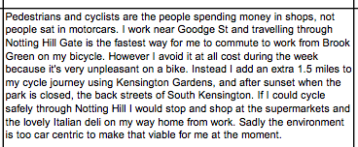by Jonathan Gregson
A grid is defined as “a network of lines that cross each other to form a series of squares or rectangles”. The Bike Grid is described by Boris Johnson as “a new network of routes” and by TfL as “a connected, safe set of routes taking cyclists across central London”. A quick look at the map of proposed routes shows that, by and large, it does indeed consist of a series of parallel north-south and east-west routes that connect to form a grid. The glaring exception though is in the Royal Borough of Kensington and Chelsea (RBKC), where many of the proposed routes come to a sudden end without connecting. There is no continuous east-west route proposed at all north of the convoluted route through South Kensington and no sign of the promised east-west Cycle Superhighway through the borough.
Boris Johnson promises of the Bike Grid that “unlike some cycle routes in the past, they won’t give up at the difficult places.” Unfortunately, in RBKC, giving up at the difficult places is exactly what the planners have done:
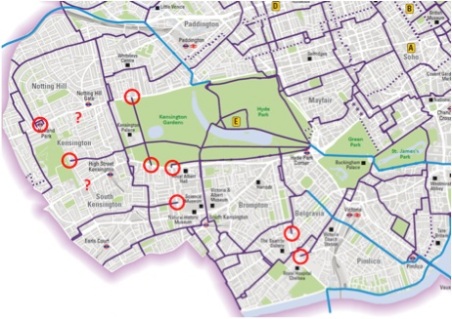
Proposed Bike Grid in RBKC – incomplete and unconnected.
When challenged with this criticism, the borough’s Chief Transport Policy Officer responded that
“where routes do not join up to other routes,they are spurs added to the proposed core network to connect either to existing cycle routes – as at Holland Walk – or to cycle hire docking stations or Tube stations.”
This is utter nonsense: why would Holland Park tube station be anyone’s destination for a journey by bike, when bikes are banned from the Central Line? What is the point of connecting to existing routes such as Holland Walk or Broad Walk, when these routes themselves do not connect to continuing routes? Such “spurs” are mentioned nowhere in TfL’s Bike Grid consultation document and are not proposed in any other borough. They are nothing more than a poor excuse by RBKC for a proposal which is so insubstantial compared to the other boroughs that those involved should be embarrassed by it. If these so-called “spurs” are removed from the map, then the proposed grid in RBGK looks like this, pathetic compared to the proposed grid of connected routes in other boroughs:
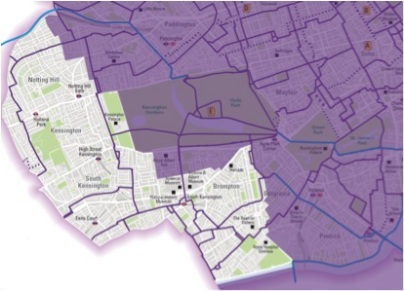
Map with only routes that connect shown: routes in Kensington and Chelsea are very sparse compared with all other boroughs.
A generous interpretation of this map is that there is one continuous north-south and one continuous east-west route through the borough, but the rest of the borough is entirely neglected.
Rather than labelling the unconnected routes as “spurs”, surely a better approach would be to connect them properly to the grid. It is not difficult, but the transport planners at RBKC seem to be incapable of it, so here is a guide for them to the “missing links” needed to turn the “spurs” into a properly connected grid.
If all these missing links were complete, the Bike Grid in Kensington and Chelsea would look very different, would provide a safe environment for encouraging increased cycling in the Borough and would be an achievement the Council could be proud of:
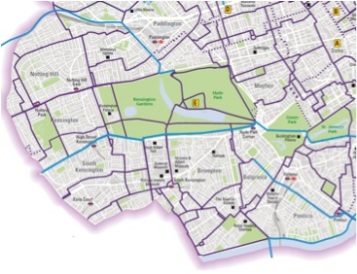
What the Bike Grid should look like in Kensington and Chelsea, as a minimum.
The Missing links: Chelsea Embankment

Management: TfL (Red Route)
Total motor traffic 34,822 vehicles per day:
HGV traffic 2,035 vehicles per day:
Pedal cycle traffic 2,456 pedal cycles per day:
Exiting cycle route: National Cycle Network Route 4
Existing facilities: Shared use pavement only
In February 2013, TfL consulted on proposals to improve conditions for cyclists and pedestrians on Chelsea Embankment, including some advisory cycle lanes “where feasible”. Unfortunately it was a very poor design, with cycle lanes only where the existing lanes are wide enough to accommodate them, but intermittent and disappearing at junctions.
TfL received 31 responses to the consultation. According to the consultation summary, the main issues raised were:
- “Concerns about the proximity of the cycle lanes to the parking spaces along Chelsea Embankment. Can the parking spaces be removed?
- The pavement is too narrow to accommodate the existing shared space, especially with the street furniture and trees there as well.
- The proposed cycle lanes are too intermittent and disappear at key points leading up to junctions.
- The proposed cycle lanes should be mandatory rather than advisory as the proposal gives no protection to cyclists.”
Following the consultation, rather than improving the design, TfL decided to scrap the proposed cycle lanes entirely.
“The decision to delay implementing the cycle lanes follows the publication of the Mayor’s Vision for Cycling in London. Our focus is to deliver a planned network of cycle routes throughout the city, and we need to give further consideration as to how the proposed cycle lanes on Cheyne Walk / Chelsea Embankment fit in with this Vision.”
It is puzzling therefore that the proposed Bike Grid has been published, but no cycle route is proposed on Chelsea Embankment.
TfL is correct that there is a need for a safe cycle route along Chelsea Embankment (and Cheyne Walk). No other straight east-west route is available between the Embankment and Hyde Park, and it provides access to the excellent CS8 into Westminster. The current shared use pavement is not fit for use as it is an uneven surface and virtually impossible to access or exit safely.
TfL was also correct to scrap the previous poor proposal but now is the time to come up with something better, to integrate this route into the Bike Grid, and do it properly by removing the dangerous car parking and installing compulsory cycle lanes in each direction.
This is an excellent example of an area where quiet backstreets simply are not available for east-west journeys, and so the Bike Grid must make use of segregated cycle lanes on main roads instead.

Most of Chelsea Embankment has room for segregated cycle lanes.
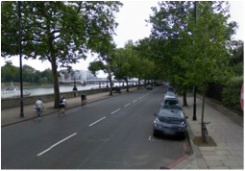
Car parking is a hazard to cyclists in places, and needs to be relocated or removed.
The Missing Links: Holland Park
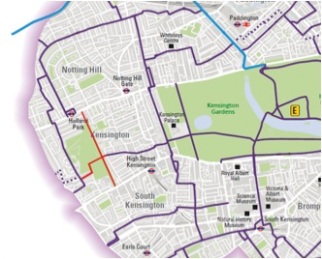
Management: RBKC
Existing cycle route: Holland Walk
Existing facilities: Shared use path through park
It is odd that the existing north-south cycle route through Holland Park, along Holland Walk, is not included in the proposed Bike Grid (existing routes through other parks are shown). Perhaps it is because currently it does not connect with continuing routes at either end. Cyclists arriving at Holland Park Avenue at the north end are greeted with a metal barrier and a “cyclists dismount sign”. Turning right from Notting Hill Avenue (eastbound) into Holland Walk is an impossible manoeuvre, as is turning right from Holland Walk into Holland Park Avenue.
It is the same story at the south end, with no legal way for cyclists to turn right from Kensington High Street (westbound) into Holland Walk, or left from Holland Walk into Kensington High Street.
All that is required (as a minimum) is a toucan crossing and small area of shared use pavement at each end of Holland Walk, so that cyclists can enter and exit Holland Park safely and legally.
Even worse is the complete lack of provision for crossing Holland Park east-west by bicycle. Bizarrely, the proposed grid shows routes leading to the east side and west side of the park, but no route through the park linking them. This “missing link” prevents would otherwise be a complete unbroken east-west route from Kensington Olympia in the west to Westminster Bridge in the east.
It is difficult to understand why an east-west route through Holland Park has not been proposed as part of the Bike Grid, given how easy it would be to achieve.
Even the Council’s own Holland Park Management Plan 2006-2016 states:
“Cyclists are forbidden under the existing bye-laws of the park–yet enforcement of the policy is both impractical and at variance with wider sustainable transport policies of government, the Mayor of London and the Council. The Parks Police patrol on bicycles and Council officers are being encouraged to follow suit…but the public remains discouraged from doing so. This needs urgent re-appraisal and a move to the American system that gives pedestrians right of way and consideration on public footpaths should be evaluated.”
Actually, there is no need to look to America – considerate cycling has been successfully permitted in parks in other London Boroughs such as Southwark and Lambeth for years.
Nor is there any need to make all paths in the park shared use, if Council officials remain concerned about potential conflict between cyclists and pedestrians. Only 200m of cycle track are required to complete the link. Simply by moving one of the entrances to the sports field, the existing path around the northern fence of the sports field could be converted to a segregated cycle track, which would result in virtually no conflict with pedestrians:

Two options for a cycle route across Holland Park: shared use path (blue) or segregated track along the north side of the sports field (red).
The Missing Links: Queen’s Gate
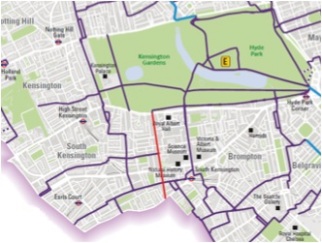
Management: RBKC
Existing cycle route: none
Existing facilities: Link with South Carriage Drive
On Queen’s Gate can be found Imperial College’s main cycle parking facility as well as the staff cycle entrance for both the Science Museum and the Natural History Museum and no less than five Cycle Hire docking stations. It connects at the north end with South Carriage Drive in Hyde Park (even with dedicated cycle traffic lights), and with the proposed Bike Grid at Queen’s Gate Place and Harrington Road. It is odd then that Queen’s Gate itself is not included in the proposed grid.
The current problem with Queen’s Gate is that despite resembling a giant car park, with four rows of parked cars along its length, the road is still very wide, which encourages cars to drive at high speed. The road markings at junctions encourages traffic to use two lanes, which squeezes cyclists between parked cars and fast-moving traffic, increasing the risk of being hit by a car door and making it dangerous to change lane in order to access the Cycle Hire docking stations on the central reservation, or to turn right.
Queen’s Gate is primarily a residential street, and there is no need for two lanes of traffic in each direction. There is plenty of road space to introduce a generous cycle lane in each direction. If two lanes of traffic are required at junctions, this could be maintained simply by removing a small amount of parking along the central reservation at junctions. Apart from that, there would be no need to remove car parking – although it may be safer to run the cycle lanes behind parked cars (and bus stops).
There is also an urgent need to improve the provision for cyclists turning right from Queen’s Gate (northbound) into Museum Lane, Imperial College Road and Prince Consort Road, and for southbound cyclists to turn right into Queen’s Gate Place.
This route could also be continued along Old Church Street as a direct north-south Quietway, linking Hyde Park with the river at Cheyne Walk.
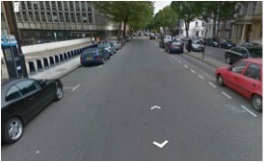
Plenty of space for car parking as well segregated cycle lanes on Queen’s Gate.
The Missing Links: Kensington High Street and Cycle Superhighway 9
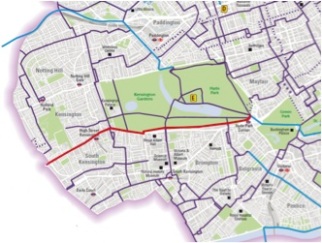
Management: RBKC
Total motor traffic 21,361 vehicles per day:
HGV traffic 780 vehicles per day:
Pedal cycle traffic 2,913 pedal cycles per day
Existing cycle route: None
Cycle Superhighway 9, due to run between Hounslow and Hyde Park, is conspicuous by its absence from the Bike Grid map. TfL’s website still says it is due to open in 2014 – though this seems unlikely!

It seems that plans for CS9 have been abandoned, because RBKC have blocked TfL’s proposed segregated cycle lanes along Kensington High Street, not because of any sound argument, but because they are intransigent in their belief that, to quote the Council Leader “no one form of travel should be considered over all others” and therefore that cycles should mix with motor traffic. This is particularly galling for the residents of Hounslow who will now not get a safe route into central London, because RBKC will not allow it safe passage through the Borough.
It is clear from the map of the proposed Bike Grid that there is a need for a safe cycle route along Kensington High Street from Hammersmith to Exhibition Road, to enable people to choose to travel by bike from West London into the city centre.
Kensington High Street is a wide road and there is no reason why space cannot be allocated to cyclists here, as has been successfully achieved on Grosvenor Road and Millbank (which carries more traffic), where road space has been re-allocated to Cycle Superhighway 8 without adversely affecting motor traffic too much.
On Kensington High Street the carriageway is, on average, 16m wide. It narrows twice to 11m (at Earls Terrace, and at the Royal garden Hotel) and widens to over 20m in places. The London Cycle design standards recommend a minimum width for a two-way cycle track of 3m, but 4m where space permits. Even at these two “pinch points” there is still room for a 4m cycle track and a single 3.65m lane for motor traffic in each direction. Where the carriageway is the average width of 16m, there would be space for a 5m wide two-way cycle track, plus a single 3.65m lane for motor traffic in each direction and a further 3.7m which could be an extra lane, or space for bus stops or loading bays. In the places where the carriageway is in excess of 19m wide, there is space for a 5m cycle track plus four 3.65m traffic lanes.
RBKC seem to be particularly concerned that a segregated route could not be designed without threatening the safety of pedestrians or bus users. Routing cycle tracks on the inside of bus stops would be hugely beneficial to the safety of cyclists, with only small inconvenience to pedestrians, and is standard practice in the Netherlands. Space is reallocated from the road, not the existing pavements, so there would be no reduction in pavement width.
Furthermore, the Transport Research Laboratory has been asked to carry out a trial of bus stop bypasses on behalf of TfL, to investigate the best configuration to minimise conflict between cyclists and pedestrians crossing between the main footway and the bus stop island. Different layouts are being tested under different levels of pedestrian and cyclist flows taking particular account of pedestrians with impaired vision or mobility. RBKC should not rule out segregated cycle lanes without even considering the results of these trials.

Kensington High Street: pedestrians are able to dodge the traffic to scurry across at will, but could not manage to safely cross a cycle track?
As a pedestrian, I find it bizarre that RBKC should think that removing lanes of traffic and replacing them with cycle tracks should make the environment worse for me. It is the congestion, noise, pollution and risk of injury produced by four lanes of motor traffic which makes the environment hostile and off-putting to shoppers. It is odd that the council seems to be proud of the fact that pedestrians are able to scurry across four lanes of traffic, if they can dodge the cars, busses and lorries in time, at will but would be unable to negotiate crossing two cycle lanes.
There is also plenty of evidence that if the council moved to discourage through traffic from Kensington High Street, and encouraged cyclists into the area, that local businesses would benefit financially.
RBKC therefore needs to work with TfL to make Cycle Superhighway 9 a reality.
The Missing Links: Holland Park Avenue/Notting Hill Gate/Bayswater Road
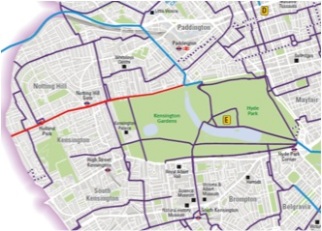
Management: RBKC
Total motor traffic (average) 27,795 vehicles per day:
HGV traffic (average) 857 vehicles per day:
Pedal cycle traffic (average) 2,239 pedal cycles per day:
Exiting cycle route: None
A route from Holland Park roundabout, along these roads as far as the Broad Walk on Kensington Gardens (and continuing, under Westminster Council’s control, as far as North Carriage Drive) would provide a much–needed east-west route to the north of the borough, as well as connecting some of the proposed unconnected routes. It is another example of an area where suitable quite back streets do not exist, so the Bike Grid must use segregated facilities on main roads instead. This wide, tree-line boulevard consists of a minimum of four lanes of traffic through most of its length.
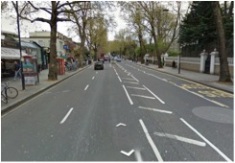

Holland Park Avenue and Notting Hill Gate: currently hostile to cyclists, but plenty of room for segregated cycle tracks.
The average daily traffic flow along this road in 2012 varied from 27,547 to 28,343 motor vehicles per day (depending on the section measured). Grosvenor Road between Chelsea Bridge and Vauxhall Bridge, which was recently reduced from two to one lane of traffic in each direction to accommodate generous cycle lanes for CS8, has higher traffic flows (30,191) yet the reduction to a single lane has not resulted in any significant congestion. There is scope therefore to re-allocated road space on Holland Park Road, Notting Hill Gate and Bayswater Road to accommodate a segregated cycle lane in each direction similar in style to the new segregated route along Stratford High Street. This could be flagship cycle project for RBKC, which is currently planning improvements to Notting Hill Gate.
The Missing Links: Chelsea Bridge Road.

Management: RBKC /City of Westminster
Total motor traffic: 14,587 vehicles per day
HGV traffic: 363 vehicles per day
Pedal cycle traffic: 5,155 pedal cycles per day
Exiting cycle route: LCN 5
Chelsea Bridge Road links the proposed “Circle Line” route with the existing Cycle Superhighway 8 and already has segregated cycle lanes along most of its length, so it would make sense to include it in the Bike Grid. It is already used by a very high number of cyclists – over 5,000 per day on average.
The only problem at the moment is the junction of Chelsea Bridge Road and Grosvenor Road. Currently, it is impossible for cyclists travelling westbound along CS8 on Grosvenor Road to (legally) turn right into Royal Hospital Road (despite TfL’s Journey Planner often recommending this turn as part of its suggested cycling routes).
Currently, a toucan crossing allows cyclists wishing to turn right to cross Grosvenor Road onto the north pavement. However, there is no equivalent facility to cross Chelsea Bridge Road. Conversion of this crossing to a toucan would enable the turn to be completed by bike.
Even better would be a simple facility for performing a right turn, such as that found on Vauxhall Bridge, which combines toucan crossings with a short section of segregated cycle track on one side, and an area on the central reservation adjacent to the crossing for cyclists to wait to complete the turn.
For cyclists on Chelsea Bridge Road (southbound), the cycle lane needs to operate around the clock, and continue all the way to the advanced cycle box at the junction (behind the bus stop and disabled parking for the Lister Hospital if necessary).

(L) Facility enabling cycles to turn right from Albert Embankment onto Vauxhall Bridge. (R) Similar facility required at Grosvenor Road/Chelsea Bridge Road.
The missing links: Sloane Square.
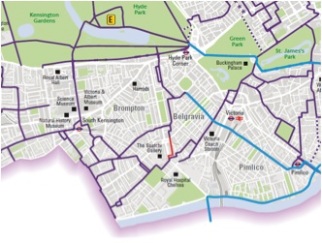
Boris Johnson promises of the Bike Grid that “unlike some cycle routes in the past, they won’t give up at the difficult places.” Unfortunately, the planners of the Bike Grid do seem to have given up at Sloane Square. All that is required to complete the missing link is:
- Close Sedding Street to motor traffic. The south end of Sedding Street could become a paved shared space for cyclists and pedestrians, with more space for outdoor seating outside the Botanist.
- The entrance to Holbein Place from Sloane Square in front of the tube station creates conflict between pedestrians and motor vehicles, and should be closed to motor traffic.
- Relocate the bus stand outside the Royal Court Theatre, and create a section of two-way segregated cycle track running along the east side of Sloane Square connecting Sedding Street with Holbein Place.
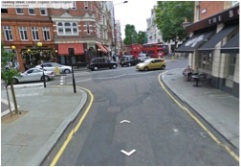

Close and re-landscape end of Sedding Street, replacing zebra with toucan crossing. Relocate the bus stand and replace with two-way segregated cycle track.






















